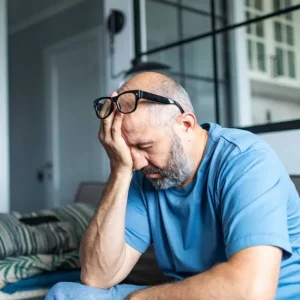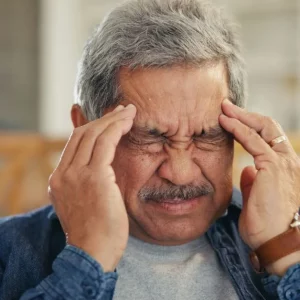Restless leg syndrome after stroke can lead to insomnia and affect your quality of life. Therefore, treatment is often desirable for many patients. But where do you start?
In this article, we will discuss the causes, symptoms, and treatment for restless leg syndrome after stroke.
What is Restless Leg Syndrome?
Although there are a variety of sensations experienced with restless leg syndrome after stroke, the most common is the overwhelming desire to move your legs, as the name implies.
Restless leg syndrome (RLS), also known as Willis-Ekbom Disease, causes unpleasant sensations in the legs coupled with an urge to move them. This may result in sleepless nights which snowball into other secondary effects from stroke, like daytime sleepiness and chronic fatigue.
The cause of restless leg syndrome after stroke is unknown in most cases. Surprisingly, RLS impacts about 10% of Americans regardless of a stroke diagnosis, according to the National Institute of Neurological Disorders.
Though it can occur at any age, RLS is often experienced more severely in middle age or later. Additionally, women are twice more likely than men to have RLS.
The Basal Ganglia & Restless Leg Syndrome After Stroke
While the cause of restless leg syndrome is a mystery, many studies suggest that symptoms associated with RLS emerge within a few days following stroke. Newer research is examining the relationship between RLS and strokes involving the basal ganglia.
The basal ganglia is a cluster of neurons located deep in the cerebral cortex. It plays an essential role in helping the brain coordinate movement. It regulates a balance between the agonist muscles (muscles that initiate movement) and antagonist muscles (muscles that inhibit movement).
If a stroke damages part of the basal ganglia, its ability to keep this balance is disrupted and can cause abnormal muscle movements, resulting in twitching, stiffness, tremors, and other irregularities.
Other Causes of Restless Leg Syndrome After Stroke
Restless leg syndrome after stroke share similar risk factors such as smoking, high blood pressure, high cholesterol, diabetes, and obesity. Obesity can cause a disruption in the dopamine pathways in the brain, which can also contribute to RLS symptoms.
Other potential causes of RLS include:
- Sleep deprivation
- Genetic predisposition
- Environmental triggers
- Low levels of iron in the brain
- Medications taken to treat conditions such as allergies
- Nausea
- Depression
- Psychosis
Caffeine or alcohol consumption can also trigger or intensify symptoms. Restless leg syndrome can also result from other health conditions, like peripheral neuropathy, diabetes, or kidney failure. In these cases, treating the primary condition may resolve RLS symptoms.
Symptoms of Restless Leg Syndrome
Common symptoms of restless leg syndrome include:
- A desire to move legs especially when sitting still or lying in bed.
- Abnormal leg sensations (e.g., tingling, crawling, or pulling.)
- Worsened symptoms at rest and end of the day.
In the case of mild restless leg syndrome, these symptoms may not occur every night and can mistakenly be attributed to restlessness, anxiety, or stress.
More severe cases of RLS can make it difficult to enjoy and engage in the simplest activities such as sitting on a plane for a long period of time or sitting through a movie.
Treatment for Restless Leg Syndrome
There are several options available to help treat the symptoms of restless leg syndrome after stroke. The best way to treat RLS is to treat the symptoms, according to the National Institute of Neurological Disorders and Stroke.
Moving your legs, or walking around may provide some temporary relief. Also, in the case of an underlying medical condition, such as iron deficiency anemia or diabetes, appropriately treating the original condition can provide relief towards RLS.
Other treatment options include:
Lifestyle changes
- Reduce or eliminate intake of caffeine, alcohol, and tobacco.
- Strive for a regular sleep schedule.
- Get some exercise every day.
- Consider wearing compression during the day.
- Massage or stretch your leg muscles in the evening.
- Soak in a hot bath before bed.
- Use a heating pad or ice pack when experiencing symptoms.
- Arrange activities that require prolonged sitting earlier in the day rather than letter.
- Take a look at your diet to make sure you are getting enough essential vitamins and nutrients.
- Consider increasing foods with vitamin C to increase your iron absorption.
Supplements
- Iron supplements may be helpful if you have iron deficiency.
- Magnesium supplements or magnesium oil have been shown to help improve restless leg syndrome.
Before adding supplements to your diet, it’s important to consult your physician or nutritionist.
Medications
- Dopaminergic agents can help decrease motion in your legs.
- Narcotics such as opioids can decrease pain and strange sensations and help you relax.
- Sleep aids and muscle relaxants such as benzodiazepines can help you relax and sleep better.
Though there is no cure for restless leg syndrome, managing the symptoms will provide relief. For treatment options, it is best to consult your doctors to see what treatment and/or medications would be appropriate for you!









